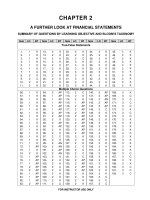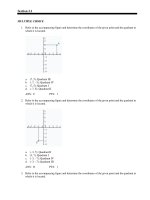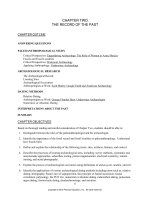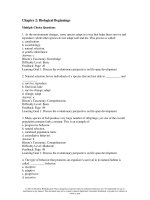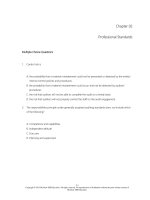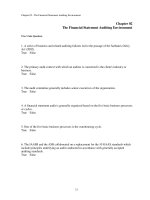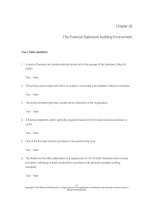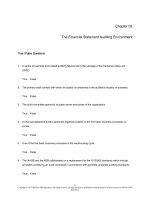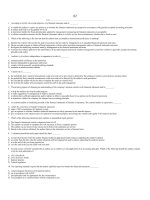Community policing a contemporary perspective 6th edition kappeler test bank
Bạn đang xem bản rút gọn của tài liệu. Xem và tải ngay bản đầy đủ của tài liệu tại đây (118.8 KB, 3 trang )
Kappeler: Community Policing, 6th Edition
Chapter 02: A History of Communities and Policing
Test Bank
1. According to your textbook, the saying “____________” ignores the role power plays in
the kind, quality, and distribution of police service.
*a. people receive the kind of policing they deserve
b. people are evil
c. people never get what they deserve
d. none of the above
2. Most transformations in policing were the result of which of the following pressures:
a. continued population growth
b. a shift from an agrarian to an industrial economy
c. crowding of people into cities
*d. all of the above
3. Every 10 citizens constituted a tithing and every 10 tithings made up a ____________.
*a. hundred
b. thousand
c. ten thousand
d. two hundred
4. ____________ were charged with surveying land, checking weights and measures,
serving warrants, and meting out punishment.
a. shire-reeve
b. shire
*c. constable
d. night watches
5. A group of hundreds was organized into a ____________, the rough equivalent of a
county.
a. tithing
*b. shire
c. community
d. town
6. A ____________ supervised shires.
a. night watch
b. constable
*c. shire-reeve
d. slave patrol
7. Edward II established a new office; ____________, filled by noblemen appointed by the
king.
a. constable
*b. justice of the peace
c. shire-reeve
d. bobbies
8. During the eighteenth and nineteenth centuries, lands that were used by entire
communities, called the “commons,” were consolidated and privatized with a series of acts
of Parliament. What was this act called?
a. Civil Service Act
b. Combination Act
c. Commons Abolishment Act
*d. Enclosure Act
9. The ____________ prohibited workers from meeting, organizing, and striking against
their “masters” to improve working conditions.
*a. Combination Laws
b. Enclosure Act
c. Strike Laws
d. Anti-Union Act
10. Many modern American police organizations were birthed from ____________.
*a. slave patrols
b. constables
c. British control of the new world
d. England policing strategies
11. The police are social control agents, an institution of government that imposes the force of
law on the public.
*a. True
b. False
12. A main challenge in the United States has been to fashion a structure for the police that
insulates departments from the corrupting influence of politics, without risking a department so
autonomous that it is isolated from accountability to the people.
*a. True
b. False
13. Policing became formalized with the adoption of regular night watches.
*a. True
b. False
14. The history of law enforcement in England can be divided into four distinct, successive
periods.
a. True
*b. False
15. Sir Robert Peel introduced the Metropolitan Police Act of 1829.
*a. True
b. False
16. British police officers were considered skilled laborers.
a. True
*b. False
17. The American system of policing evolved from an amalgamation of systems from England,
France, and Spain.
*a. True
b. False
18. Slave patrols and night watches had different primary objectives depending on the part of the
country in which they were located.
*a. True
b. False
19. In the American colonies, justices of the peace were among the first law enforcement
officers.
a. True
*b. False
20. Political elites, rather than the community, became the controllers of the police.
*a. True
b. False
